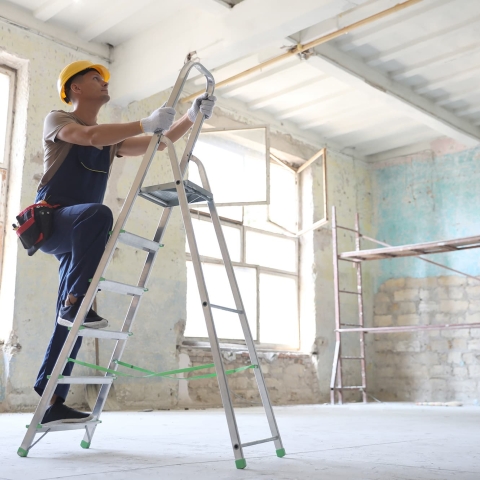Ladder Safety: Protecting Your Business and Employees

Promote a Culture of Safety Within Your Organization
Picture this: a bustling workplace filled with dedicated employees striving to meet deadlines and exceed expectations. Amidst the hustle and bustle, a simple ladder is being used to reach high shelves or complete maintenance tasks. It may seem like a harmless tool, but without proper precautions, it can quickly turn into a silent threat.
Ladders are common tools in many workplaces; however, their improper use can lead to serious accidents and costly liabilities. At Indiana Farmers Insurance, we prioritize safety, which is why we've compiled essential information on ladder safety for your business.
Choose the Right Ladder
Selecting the appropriate ladder for the task is crucial. Different jobs require different types of ladders, such as stepladders, extension ladders, or platform ladders. Ensure that the ladder's weight capacity is suitable for the user and account for any equipment they may be carrying as well.
Read and Follow Manufacturer Guidelines
Make sure you carefully review and follow the manufacturer's guidelines and warning labels when using the ladder.
Inspect Your Ladder
Before each use, inspect the ladder for any visible defects or damage, such as cracks, missing rungs, or loose hardware. If you notice any issues, remove the ladder from service immediately and repair or replace it.
Proper Setup
When setting up the ladder, make sure it is on a stable and level surface. Use ladder levelers or leg extensions for uneven terrain. Always extend the ladder to the recommended height and lock it securely in place.
Maintain Three Points of Contact
Employees should maintain three points of contact (two hands and one foot or two feet and one hand) when climbing up or down a ladder. This provides stability and reduces the risk of falling.
Face the Ladder
Always face the ladder when ascending or descending. Avoid overreaching or leaning to the side, as this can cause the ladder to become unsteady.
Stay Centered
Keep your body centered between the ladder's side rails and avoid leaning too far in any direction. Reaching too far to one side can cause the ladder to tip/fall over.
Using Tools Securely
If you need to use tools or equipment while on the ladder, make sure they are secure and within easy reach. Use tool belts or holsters to keep your hands free for climbing.
Emergency Preparedness
Have a plan in place for emergencies. In the event of an accident or fall, employees should know how to respond, including calling for medical assistance if needed.
By following these fundamental ladder safety guidelines, your business can help reduce the risk of accidents, injuries, and potential insurance claims. Prioritizing safety not only protects your employees but also safeguards your business from costly liabilities.
Remember that ladder safety is a shared responsibility. Promote a culture of safety within your organization, where employees are encouraged to report damaged or unsafe ladders and share best practices. At Indiana Farmers Insurance, we are here to support your commitment to workplace safety and provide the insurance coverage you need to protect your business and employees.
Sources: OSHA, NIOSH
The information presented in this document is for informational and educational purposes only. It is intended to assist individuals, farmers, and business owners in identifying common hazards/risks and considering proactive loss prevention or loss mitigation actions. For information related to specific loss hazards, please contact your insurance agent.

